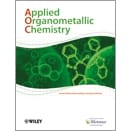 Rick Laine edited a special issue in the journal Applied Organometallic Chemistry Volume 24, issue 8. In the preface he writes:
Rick Laine edited a special issue in the journal Applied Organometallic Chemistry Volume 24, issue 8. In the preface he writes:
“The field of hybrid materials can trace its origins to sol-gel chemistry, pre-ceramic polymers, polymer intercalation of low-dimensional inorganics and biomimetic materials processing. Basically, the field of hybrid materials can be defined as the development of synthetic, characterization and modelling methods that allow researchers to assemble organic and/or inorganic nano-composites with complete control of mixing over multiple dimensional scales. The impetus for the recent exceptional growth of this field derives from the fact that it allows the combination of the properties of organic materials with those of inorganic materials at length scales that permit the tailoring of global properties (transparency, conductivity, photonic properties, etc.) with exceptional control. There are now more than 6000 articles published on hybrid materials each year.”
This special issue publishes recent advances and ‘Future Trends in Organic/inorganic Nanocomposite Hybrid Materials.’ The work contained in this issue consists of papers from the majority of the participants in the US-Japan workshop of the same title held in Himeji, Japan in May 2009. This is the fifth three-year workshop on these materials and the papers represent the state of the art in hybrid materials design, synthesis, characterization and modelling.

















